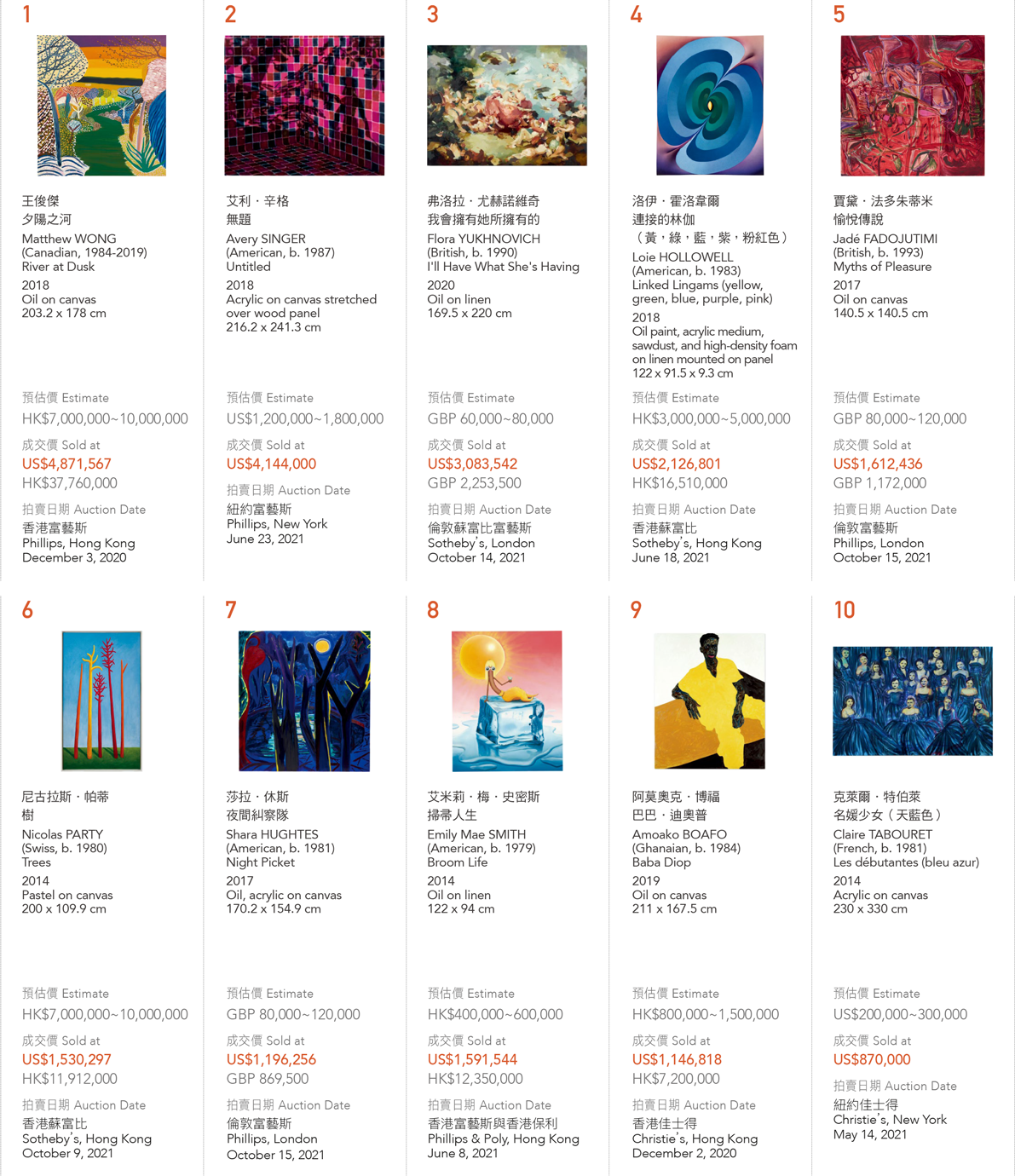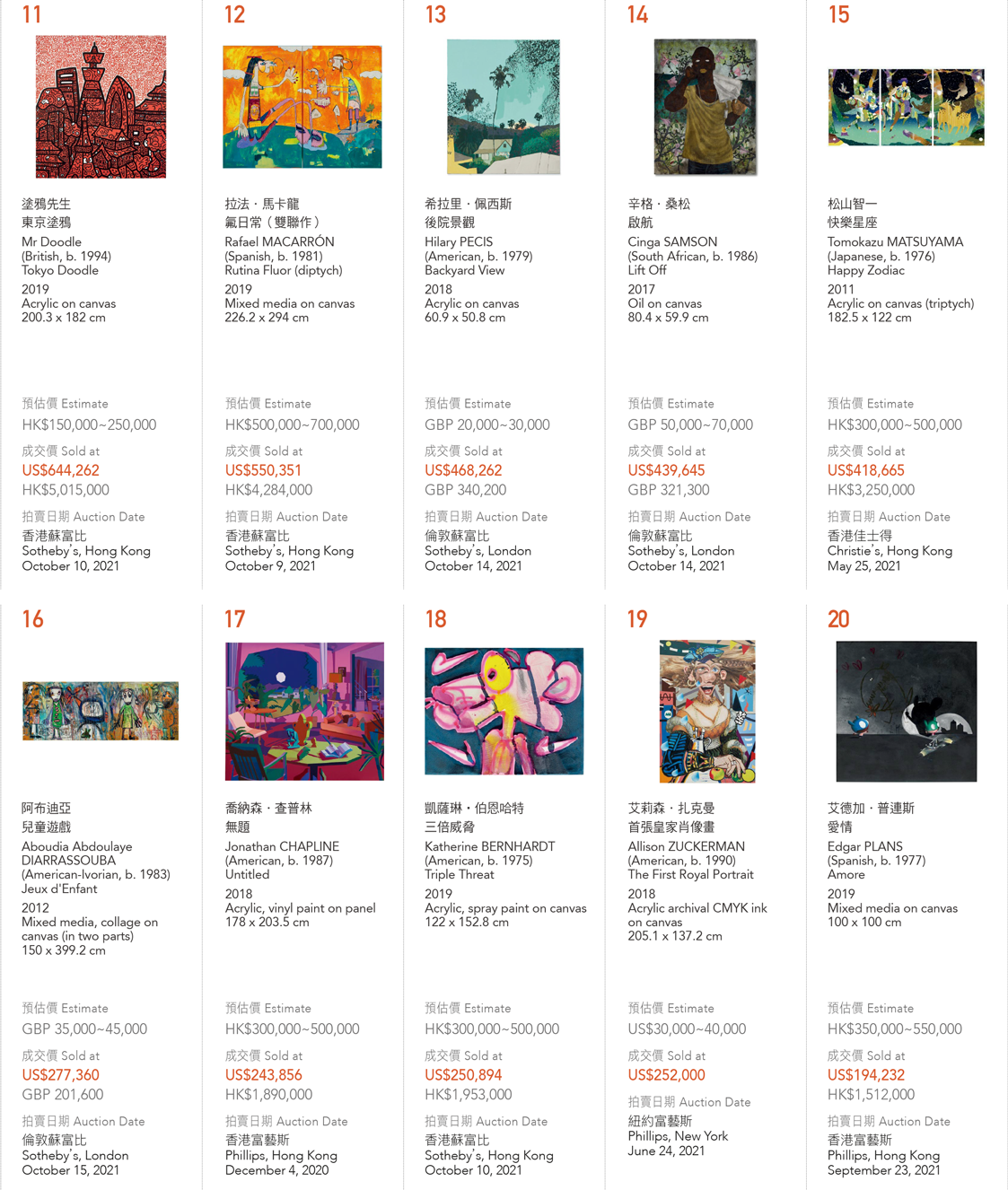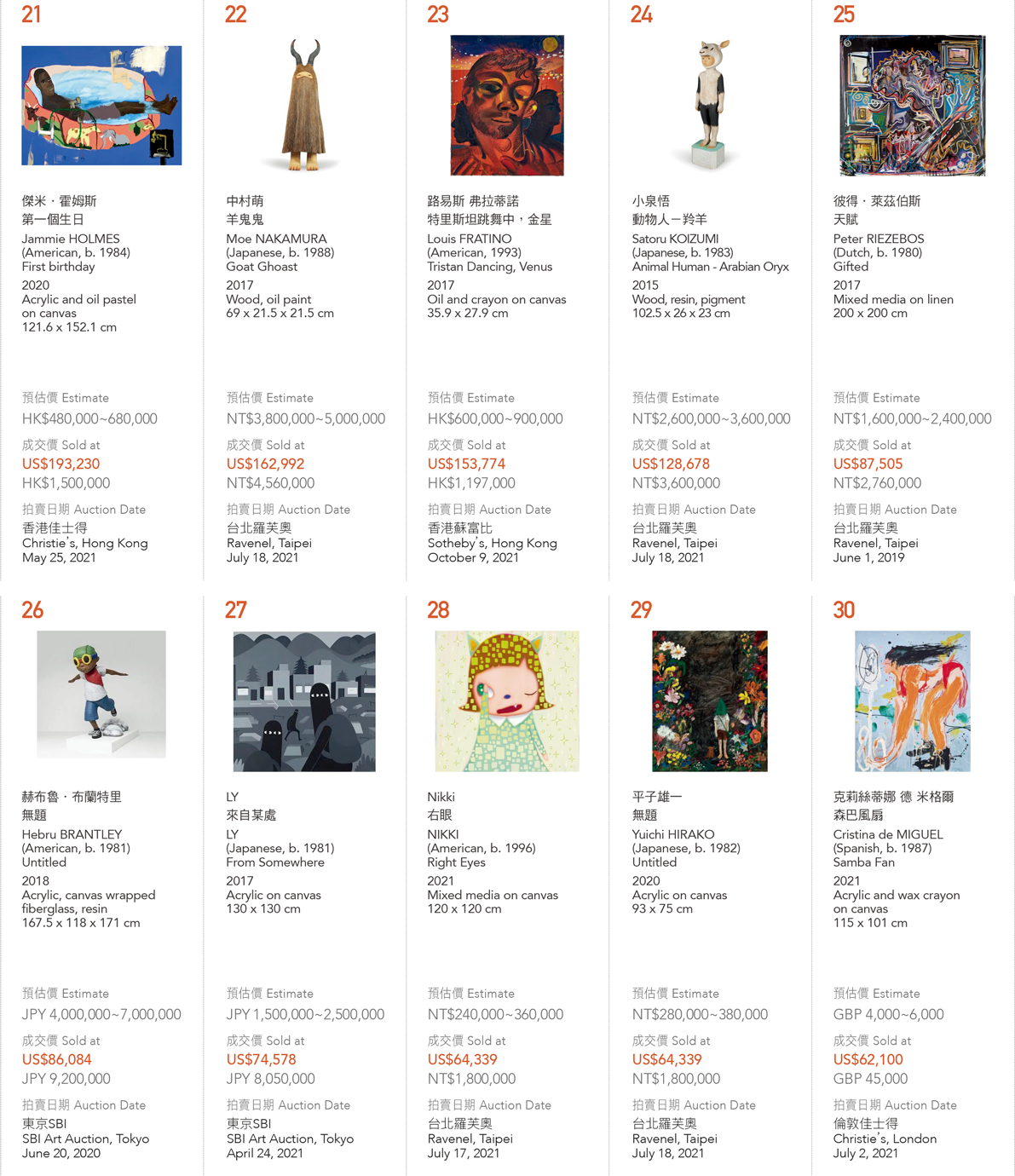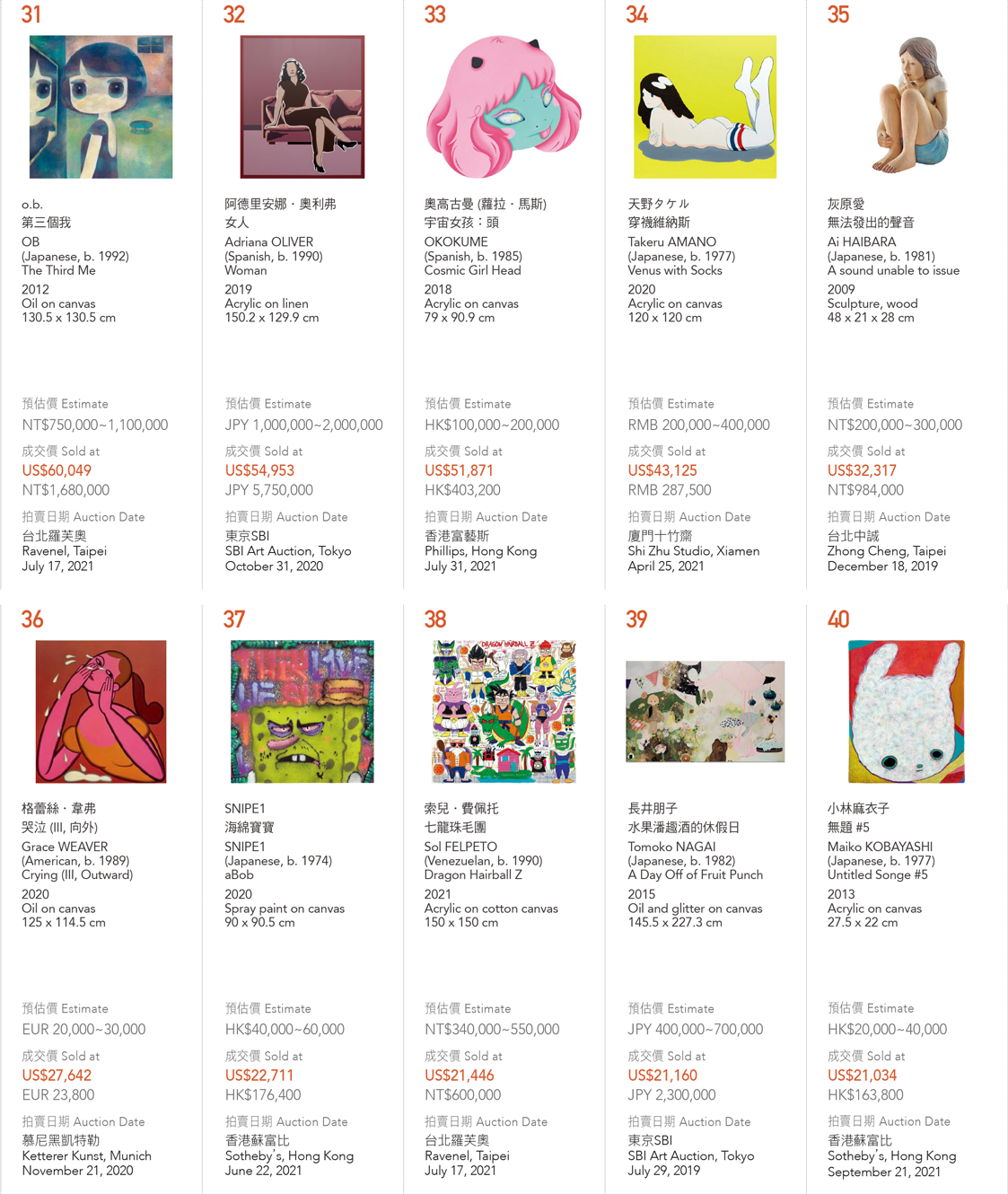The Entrance of A New Generation - Discovering Rising Stars of The International Art Market
Odile Chen / Ravenel Quarterly No. 37 / 2021-11-17
In the current environment of monetary easing and inflation, art has become a popular investment and a destination for parking money. During the COVID-19 pandemic, online virtual exhibitions and art fairs, as well as online and offline art auctions have been producing impressive results. From the special features of various international auction houses, it is easy to see the increasingly important role of art from the amount and proportional value of contemporary art. According to Artprice's Contemporary Art market Report in 2021, from July 2020 to June 2021, the global auction market accumulated more than $2.7 billion in contemporary art transactions, an unprecedented amount that is more than double the same period last year. Contemporary art auction sales in the first half of 2021 alone have already exceeded the total for the entire year of 2020. It is now obvious how the pandemic has not had a cooling effect on the market, but rather the opposite. No matter the number of works, the amounts and rates of transactions are higher than in the past.
Adventurous Millennial Collectors Make a Big Entrance
According to recent market data, works by young artists appearing in auctions has been steadily increasing. As I analyze the auction records of contemporary artists, I must constantly update the market. I believe that these figures are only temporary, and that auction records will continue to transform in the future. A common feature of the stars of tomorrow is that young artists with potential and high degree of inquiry have traded at prices several times or even dozens of times higher than their auction valuation within a short time. Outstanding artists quickly become popular and are trending in the auction market.
The classification of artists' careers in the general art circle can be roughly divided into three categories: emerging artists, mid-career artists, and established artists. Age and experience are the primary criteria to classify these three categories of artists. Of course, in reality, the market is also the decisive factor. This article proposes that Asian collectors are more familiar with the potential of contemporary artists. Most of them choose international contemporary artists born after 1980 (so-called post-80s and post-90s, or under-40s), classified as emerging artists or emerging-to-mid-career artists. Due to constraints of space, this paper offers only a limited sample size that only reflects a portion of the market, so it is difficult to represent the whole picture.
Along with time, this trend in art has been increasingly emerging. Recently, a large number of young collectors have joined the art market. This group of so-called "millennial" (born from 1981 to 1996) or "generation Y" new collectors tend to have different orientations for collection from their predecessors, the "post-war baby boomers" (born from 1946 to 1964) and "generation X" (born from 1965 to 1980). Growing up during the rapid development of the Internet and benefiting from the era of globalization, millennials are also known as the "Internet generation". This generation has its own collection preferences with preferences for high-profile, visual, fashionable, and topical art. These newcomers to the art market also tend to be bolder than more experienced art investors. Today, young collectors in the auction field are particularly adept at taking advantage of resources. They dare to bid, are happy to share the community, and greatly increase auction turnovers.
The influx of millennial collectors into the auction market has also helped to increase the activities and popularity of online and physical auctions. Millennials tend not to reject the idea of art collection being a valid form of investment. They like the art of their generation and are less price-sensitive when buying. They can browse through online platforms to purchase art, find artists from Instagram or TikTok, follow influencers, or share their successes with the community and feel a sense of accomplishment. If they feel that the works they've purchased and collected are inappropriate, they tend to be decisive about letting them go, speeding up the trading frequency of the art market. This is why millennials are customers with high potential in the art market.
Art stratosphere displayed under big data
Although millennials wield a promising level of purchasing power, it cannot be denied that their predecessors, the baby boomers and Gen-Xers, are still the big players in the art collection industry. They still dominate the markets in antique calligraphy and painting, modern classics, post-war art and other projects, and appreciate diversity and personalization. Among Taiwan's celebrity collections, most of the top corporate collectors of Ching Wan Society art are baby boomers. Their collections span works from China and the West with a particular affinity for niche art. Spanning 41 to 56 years of age, Generation X, is currently in the most affluent stage of middle age with a familiarity of the Internet. Gen-X collectors integrate the art collection habits of two generations and are more likely to accept trendy and avant-garde contemporary art than baby boomers.
The Internet generation responds to the development of social groups, and the collection taste of well-known artists or online celebrities influences the preferences of their followers. Because of online communication, millennial collectors tend to have a similar collection style. Fans follow social media influencers and celebrities, and new artists will also be discovered by talent scouts through social media. The most famous example is Genieve Figgis, an Irish artist who shared her works on Twitter and attracted the attention of Richard Prince, a well-known American artist who bought her paintings and recommended her to the art world in New York. This story has inspired many struggling young artists to follow suit.
Self-taught Chinese-Canadian artist Matthew Wong was described by the New York Times as "one of the most talented painters of his generation". However, he suffered from autism and Tourette's syndrome for a long time. He committed suicide in 2019, ending a short 35-year life. The following December, River at Dusk sold in Hong Kong for HK$37.76 million (US$4.87 million or NT$143 million). In modern times, a century is no longer required for artists to "become van Gogh"—just one year is enough to reach such a legendary status. Mr Doodle, born in 1994, had a strong drive to create graffiti art, but a sudden wave of fame caused his mental health to suffer. When he was in his twenties, he achieved global fame, setting a record of HK$5 million (US $640,000 or NT $18 million) in auction houses.
The Way to Fame for Emerging Artists
Gallery brokers and auction specialists need to constantly come up with new subjects. Since classic works of modern and contemporary masters are unavailable or unaffordable, it became common practice to find topics from contemporary art, such as popular art, graffiti art, African-American or Black artists, Central and South American artists, female artists, LGBTQ artists, etc. Recently, the Internet has been flooded with articles on "‘X Emerging Artists' or ‘New Stars' You Need to Know" and similar topics to attract new, young buyers with relatively low price thresholds.
Excellent emerging artists bring their own traffic through media or online communities and have the attention of fans from all over the world. They can be quickly discovered by galleries or brokers in top markets or recommended to collectors and museums. Then they may collaborate with fashion brands or issue prints, dolls, and other merchandise, expand the customer base, and even enter auction platforms in the secondary market. Recently, it has also been found that artists selling on auction platforms have attracted large international galleries to negotiate agency and exhibition agreements, such as Claire Taboulet from France and Edgar Plans from Spain. These artists originally worked with small galleries, but later signed agreements with the well-known Almine Rech Gallery. The gallery also won the opportunity to cooperate with Javier Calleja, a rising star in art auctions.
To judge the popularity of emerging artists, we can look for clues from the sales records of galleries, art fairs, and auctions. In particular, after the market for trendy artists opens, they will cooperate with brands to create merchandise. Some famous examples of artists who created limited edition co-branded prints or plural doll toys include "AllRightsReserved": KAWS, Joan Cornellà; "Avant Arte": LY, Roby Dwi Antono, Adriana Oliver, Tomokazu Matsuyama, Aya Takano, Hebru Brantley, Claire Tabouret; "Case Studyo": Javier Calleja, Johnson Chaplin, Daniel Arsham; "APPORTFOLIO": Satoru Koizumi, Takeru Amano, Hikari Shimoda, Yuichi Hirako, Katherine Bernhardt, Mr. A, Gary Baseman; "Medicom Toy": Taku Obata; "VTSS": Mr Doodle, Roby Dwi Antono, Yosuke Ueno.
Whether we look at artists like James Jarvis or KAWS, who became popular from trendy clothing and enamel toys 20 years ago, or Moe Nakamura, Ikumi Nakada, and Kasing Lung, who rose in a recent toy exhibition, are all successful examples that people like to talk about. Once the limited edition prints or dolls are launched, they often sell out instantly. The buyers who managed to snap up a few products can then resell them for a profit. In the past few years, this has become a good business for sellers on Facebook, Line, or WeChat.
Celebrity and Brand Support: Auction Market Grows Again
After successfully transitioning into a mid-career or established artist, an artist can pursue more advanced cross-border cooperation with major fashion brands such as Louis Vuitton, Dior, Stella McCartney, Off-White, Supreme, Nike, Puma, UNIQLO, etc. Success stories include KAWS, Urs Fischer, Jeff Koons, Takashi Murakami, Mika Ninagawa, Yoshitomo Nara, Hajime Sorayama, Mr doodle, Stephen Spruse, Yayoi Kusama, Damien Hirst, Richard Prince and more. These artists combined art with fashion, bringing them closer to the general public and attracting more people to participate in art collection.
Business-minded Murakami leads the Kaikai Kiki gallery, which has seen the emergence of one outstanding artist after another, including Mr. Otaku, fantasy animator Aya Takano, psychedelic artist OB, masterpiece satirist Madsaki, and Japanese graffiti pioneer Snipe1. Perrotin, an artist of French descent who had a good relationship with Murakami Takashi, recommended these Japanese artists and helped bring their works to the international market. The Japanese art gallery NANZUKA has also proved to be very insightful and has successfully recommended Javier Calleja, Jonathan Chaplin, and Johnson Chaplin. Tomoko Nagai, a recent agent of the famous Tomio Koyama Gallery, has also been very successful in sales.
Artists KAWS and Murakami are also collectors, and artists they endorse are easily favored by collectors. Asian singer Jay Chou is a great fan of Eddie Martinez, and his close contact with the artist has also attracted much attention to his market value. In June 2021, Jay Chou's collection was auctioned off in Hong Kong with great success. Many artists set personal auction records. Roy Hollowell, Jamian Juliano Villani, Yukimasa Ida, a'strict, and Snipe1 are all Gen Y artists.
Trend Art, Street Art, and Racial and Gender Equality: Return to the Original Spirit of Art
Graffiti art began in the streets. Pioneering artists in the 20th century—such as Keith Haring, Jean-Michel Basquiat, Invader, and Blek Le Rat, followed by Banksy, KAWS, Mr. Brainwash, and José Parlá—sought inspiration, painted patterns and reflected on street culture. More artists who followed them also became famous in the streets first. Graffiti talents such as Martinez and Shepard Fairey in the United States, JR and Supa Kitch in France, Millo in Italy, and countless artists from around the world filled the streets with vitality and surprise.
In the 21st century, the issue of respecting gender equality and people of color has attracted universal attention. In 2009, the United States elected its first AfricanAmerican President, Barack Obama. Since this historic event, long-marginalized African-American art has been receiving increasingly more attention. For most of western art's white-supremacist history, paintings rarely featured black subjects. In 2016, the Kerry James Marshall retrospective exhibition held by the Metropolitan Museum of art in New York drew public attention back to African-American art. Likewise, with the rise of women's rights, there are more female leaders all over the world, as well as in the corporate and art worlds.
Black female artists Tschabalala Self, Jadé Fadojutimi, Amy Sherald, and Madelynn Mae Green have become market favorites. Other well-known black artists include Mark Bradford, who participated in the 2016 Venice Biennale; KudzanaiViolet Hwami of the 2019 Venice Biennale, Rashid Johnson, Amoako Boafo, Henry Taylor, and Cinga Samson. The internationally renowned gallery Hauser & Wirth has represented many of these artists.
Race has always been a serious issue in the West. In 2020, the last words of George Floyd, "Please, I can't breathe", moved black artist Jamie Holmes to create performance art. The "Black Lives Matter" movement spread throughout art circles in support of the black community to improve work equity for people of color.
Emerging artists of diverse styles can flourish and leave their digital footprints on the auction platform. The table attached to this article shows the latest auction records of 40 cutting-edge contemporary artists. Almost all of the works listed were created in the past two years. This past two years has been an extremely difficult period, but it is also an era full of opportunities. The NFT art economy, which is more novel and digitized, has formed another trend in the art market. The world is changing faster than most people can imagine; we need to understand and master this trend and keep pace with the times. However, we must remember our original intention and collect works because we really like them and because they have the power to touch people's hearts, not just because they are a profitable investment. We might as well start looking for beautiful art by young artists with potential and make today's art a classic of tomorrow.
























留言
張貼留言